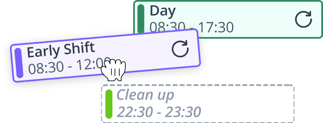This comprehensive guide will delve into presenteeism, explore its red flags, discuss its impact on employees and employers, and provide practical solutions for employers to recognize and address it.
What is presenteeism?
Presenteeism refers to employees attending work despite being ill or experiencing personal issues that may affect their ability to perform their job duties optimally.
It can manifest in various forms, such as physical illness, mental health issues, personal problems, or work-related stress.
Presenteeism can often go unnoticed, as many employees physically show up to work but may not be fully present or productive due to their underlying health or personal issues.
Causes of presenteeism
Presenteeism can have multiple underlying causes. Some of the common factors that contribute to more presenteeism in the workplace include:
- Fear of consequences: Employees may fear negative repercussions such as being perceived as less committed, passed over for promotions or even losing their job if they take time off due to illness or personal issues. This fear of consequences can drive employees to come to work even when they are unwell or struggling with personal challenges.
- Heavy workload: Employees may feel overwhelmed, leading them to come to work even when unwell to avoid falling behind or burdening their colleagues. High workloads and unrealistic productivity expectations can create a sense of pressure to always be present at work, even at the expense of one's health and well-being.
- Organizational culture: An unhealthy work culture that emphasizes long hours, high productivity expectations, and discourages time off may make employees feel compelled to show up to work even when they are not at their best. In a culture that prioritizes work over employee well-being, employees may feel pressured to prioritize work over their health needs.
- Financial concerns: Employees may worry about the financial implications of taking time off, especially if they do not have sufficient paid sick leave or are in a precarious financial situation. The fear of losing income or facing financial difficulties can drive employees to come to work even when they are not feeling well, leading to presenteeism.
- Lack of work-life balance: A poor work-life balance, with excessive demands on employees' time and energy outside of work, may make employees feel obligated to come to work despite personal issues or health challenges. When employees do not have enough time to attend to their responsibilities or care for their health, they may feel compelled to come to work even when they cannot fully perform their duties.
- Job insecurity: Employees who feel insecure about their job stability may feel pressured to show up at work even when they are unwell or facing personal challenges. The fear of losing their job or facing negative career consequences can drive employees to prioritize work attendance over their health and well-being.
- Lack of work support: Employees who do not feel supported by their managers or colleagues may hesitate to take time off when they are unwell or face personal challenges. If employees feel that their absence would burden their team or negatively impact their colleagues, they may choose to come to work even when they are not feeling well.
- Personal factors: Employees may also face personal factors such as family responsibilities, caregiving responsibilities, or personal commitments that may prevent them from taking time off when unwell. These personal factors can contribute to employees engaging in presenteeism as they try to manage their responsibilities while attending work.
It's important to note that the causes of presenteeism can vary depending on the individual, the organization, and the industry. Understanding the specific causes of presenteeism in a particular workplace is crucial in developing effective strategies to manage and mitigate it.
The cost of presenteeism in the workplace
The consequences of presenteeism can be significant and impact various aspects of employees' well-being, workplace productivity, and overall business performance. Let's explore the consequences of presenteeism in three key areas: its effect on mental health, the workplace, and its overall impact on the business.
Affect on mental health:
Presenteeism can harm employees' mental health conditions affecting job satisfaction and increasing stress and burnout. Some of the specific consequences of presenteeism on mental health include:
- Increased stress and anxiety: Employees who come to work while dealing with personal or health problems may experience heightened stress and anxiety, which can negatively impact their mental well-being.
Useful Read: Stress Leave from work: Implications and Best Practices
- Worsening of mental health conditions: Presenteeism can exacerbate pre-existing conditions such as depression or anxiety, as employees may not have the time or energy to care for their mental health needs.
- Reduced job satisfaction: Employees not fully engaged at work due to health or personal issues may feel dissatisfied, decreasing motivation and productivity.
Affect in the workplace.
Presenteeism can also impact workplace dynamics and overall productivity, as employees may not be able to perform their job duties optimally. Some of the specific consequences of presenteeism in various professional groups and the workplace include:
- Productivity loss: Employees who are not physically or mentally well may not be able to perform at their best, resulting in decreased worker productivity and lower quality of work.
- Increased errors and mistakes: Presenteeism can result in increased errors and mistakes in the workplace, as employees may not have the mental clarity or focus to perform their tasks accurately.
- Decreased morale and engagement: When employees are not fully engaged at work due to health or personal issues, it can impact the overall morale and engagement of the team, leading to decreased team cohesion and collaboration.
- Increased workplace conflicts: Presenteeism can also contribute to workplace conflicts, as employees who are not feeling well or are distracted by personal issues may be irritable or less patient with their colleagues, leading to potential conflicts and disruptions in the workplace.
The overall impact on the business:
Presenteeism can have broader implications for businesses, impacting their bottom line and overall performance. Some of the specific consequences of presenteeism on businesses include:
- Increased healthcare costs: When employees come to work unwell, it can increase healthcare costs for businesses, as employees may require medical attention for their health issues.
- Reduced productivity and performance: Decreased productivity, increased errors, and lower quality of work due to presenteeism can result in the reduced overall performance of the business, leading to potential financial losses.
- Higher turnover rates: Presenteeism can also contribute to higher turnover rates, as employees who are not feeling well or are dissatisfied with their job due to presenteeism may seek opportunities elsewhere, leading to increased recruitment and training costs for businesses.
- Negative impact on company culture: A work culture that encourages presenteeism can hurt the overall company culture. It may signal to employees that their health and well-being are not a priority, leading to decreased employee morale and engagement.
Steps to recognizing presenteeism at the workplace
- Educate Managers and Employees: Provide training and education to managers and employees about the concept of presenteeism, its impact on productivity, and how it can manifest in the workplace. Raise awareness about the signs and symptoms of presenteeism.
- Monitor Absenteeism and Presenteeism Data: Track and analyze data related to absenteeism and presenteeism, such as sick leave usage, productivity metrics, and performance indicators. Look for patterns and trends that may indicate presenteeism, such as frequent use of sick leave on Mondays or Fridays, decline in performance during certain times, or consistently working late despite being unwell.
- Conduct Employee Surveys and Assessments: Use surveys, assessments, and questionnaires to gather employee feedback about their well-being, workload, stress levels, and work-life balance. Ask specific questions related to presenteeism to gauge employees' perceptions and experiences.
- Listen to Employees: Encourage managers and HR representatives to actively listen to employees and engage in one-on-one conversations to understand their challenges, concerns, and needs. Create a safe and supportive environment where employees feel heard and valued.
- Look for Behavioral and Performance Changes: Keep an eye out for changes in employees' behavior and performance that may indicate presenteeism, such as increased irritability, reduced engagement, decreased productivity, missed deadlines, or increased mistakes. These could be signs of employees struggling with health or personal issues but still coming to work.
- Seek Feedback from Managers and Team Leads: Managers and team leads are uniquely positioned to observe and provide feedback on employees' attendance, performance, and well-being. Regularly communicate with managers and team leads to gather their insights and observations on presenteeism in their teams.
Reducing presenteeism in the workplace: 10 effective strategies
Presenteeism, the phenomenon of employees coming to work when they are unwell or unable to perform their duties, can negatively impact employees' health, workplace productivity, and overall business performance.
As a result, organizations must implement effective strategies to manage and mitigate presenteeism costs in the workplace. Here are 10 strategies that can be implemented to manage presenteeism effectively:
Roll out flexible work arrangements.

Providing employees with flexibility in their work hours and location can help them better manage their circumstances and professional responsibilities, reducing the need to come to work when unwell.
- Flexible working hours: Allow employees to control their work hours, such as coming in later or leaving earlier to accommodate personal appointments or family commitments.
- Telecommuting days: Permit employees to work a certain number of days per week or month remotely to reduce commuting time and promote work-life balance.
- Summer or Winter Fridays: Employees can leave early on Fridays during the summer or winter months or have the entire day off to allow for extended weekends.
- Compressed workweeks: Allow employees to work longer hours in a day to have a shorter workweek, such as working four 10-hour days and having a day off.
Useful Read: The 4-day Work Week The Pros and Cons and How to Implement
Create a healthy work culture.
Cultivating a work environment that prioritizes employee health and well-being can reduce the pressure to come to work when unwell and promote a healthy work-life balance.
- Promote work-life balance: Encourage employees to take breaks, use their vacation time, and prioritize their well-being.
- Recognize and reward well-being: Acknowledge and appreciate employees prioritizing their health and well-being, and incorporate well-being goals into performance evaluations.
- Foster an open and supportive environment: Create a culture where employees feel comfortable discussing their health concerns without fear of negative consequences or stigma.
Educate employees on the importance of self-care
Providing education and resources to employees about self-care and mental health can increase awareness and encourage them to take care of their well-being.
- Provide training and workshops: Offer regular training on stress management, self-care, and mental health awareness topics.
- Share resources: Provide information and resources on available support services, such as employee assistance programs (EAPs), counseling services, and mental health resources.
- Promote self-care practices: Encourage employees to prioritize self-care practices such as exercise, mindfulness, and adequate sleep, and provide resources or facilities to support these practices.
Lead by example
Leaders and managers should set a positive example by prioritizing their well-being and modeling healthy work behaviors for their teams.
- Encourage leaders to prioritize well-being: Educate leaders and managers on the importance of their well-being and how it impacts their team's productivity and engagement.
- Discourage leaders from working when unwell: Encourage leaders to take sick leave when needed and not to come to work when unwell, setting a positive example for their team.
- Promote healthy work-life balance for leaders: Encourage leaders to take breaks, use their vacation time, and demonstrate a healthy work-life balance, as their behavior sets the tone for the rest of the organization.
Provide adequate sick leave and leave policies.
Ensuring that employees have access to sufficient sick leave and other leave policies can reduce the need for workers to come to work when unwell.
- Offer sufficient paid sick leave: Provide adequate paid sick leave days per year to allow employees to take time off when they are unwell without financial stress.
- Allow for minor illness leave without medical certificates: Allow employees to take sick leave without providing a medical certificate for minor illnesses, such as cold or flu, to reduce the burden of obtaining medical documentation for every illness.
- Offer flexible leave policies: Employees can take unpaid leave or use their paid time off (PTO) for personal or family health reasons, allowing them to prioritize their well-being without losing their job or facing financial strain.
Useful Read: How to Respond When an Employee Calls in Sick: Best Practices and Tips
Implement health and wellness programs.
Implementing health and wellness programs can promote healthy behaviors and provide resources for employees to manage their well-being effectively.
- Offer wellness programs: Implement wellness programs, such as fitness challenges, mental health initiatives, or nutrition education, to encourage employees to prioritize their health and well-being.
- Resources for managing health conditions: Offer resources and support for employees managing chronic health conditions, such as access to healthcare professionals, disease management programs, or workplace accommodations.
- Create a supportive environment for healthy behaviors: Provide facilities or initiatives that promote healthy behaviors, such as healthy snacks, designated exercise areas, or walking meetings, to encourage employees to prioritize their health at work.
Foster positive relationships and communication.
Building positive relationships and open communication channels can help employees feel supported and comfortable discussing their health concerns or taking time off when needed.
- Encourage positive relationships among employees: Promote teamwork, collaboration, and a supportive work culture where employees feel comfortable asking for help or support when needed.
- Foster open communication: Create channels for employees to communicate their health concerns or need for time off, such as regular check-ins, feedback sessions, or confidential reporting channels.
- Support employees facing personal challenges: Offer resources or assistance for employees dealing with personal challenges, such as bereavement support, counseling services, or flexible work arrangements during difficult times.
Manage workloads and expectations.
Managing workloads and setting realistic expectations can help employees avoid overworking themselves when unwell and reduce the pressure to come to work when not feeling their best.
- Set realistic workloads: Ensure employees have manageable workloads and are not overwhelmed with excessive tasks or deadlines that may push them to work when unwell.
- Encourage proper time management: Provide training or resources on time management techniques to help employees prioritize tasks, avoid overworking, and maintain a healthy work-life balance.
- Foster a supportive approach to workload management: Encourage employees to communicate with their managers if they feel overwhelmed or struggle with their workload and provide support or adjustments as needed.
Provide employee assistance programs (EAPs)
Employee Assistance Programs (EAPs) can offer confidential support and resources to employees dealing with personal or work-related challenges, reducing the impact of presenteeism.
- Offer EAP services: Provide access to EAP services, including counseling, mental health support, financial advice, or legal assistance, to help employees manage personal or work-related challenges.
- Promote confidentiality and non-stigmatization: Ensure employees feel comfortable using EAP services without fear of negative consequences or stigma, and communicate the confidentiality and non-stigmatization aspects of EAPs to all employees.
- Provide information and resources on EAPs: Educate employees on the availability and benefits of EAP services through regular communication channels, such as intranet, email, or posters in common areas.
Conduct regular employee surveys and assessments.
Regularly assessing employees' well-being, workload, and job satisfaction can provide valuable insights into organizational behavior and help identify areas that may contribute to presenteeism.
- Conduct employee surveys: Administer regular surveys to assess employees' well-being, workload, job satisfaction, and perception of presenteeism in the workplace.
- Analyze survey results and take action: Analyze survey results to identify areas that may contribute to presenteeism, such as high workload, lack of work-life balance, or inadequate support for health and well-being. Use the results to identify specific areas that need improvement and take action accordingly.
- Seek feedback and suggestions from employees: Encourage employees to provide feedback and suggestions on effectively managing presenteeism in the workplace. Consider their input and implement changes based on their suggestions.
- Monitor and evaluate the effectiveness of strategies: Regularly evaluate the effectiveness of the implemented strategies in managing presenteeism by monitoring key metrics, such as absenteeism rates, productivity levels, and employee feedback. Adjust the strategies as needed based on the outcomes of the evaluations.
Technological solutions to presenteeism
 In addition to the strategies mentioned above, technological solutions can also play a role in managing and mitigating presenteeism in the workplace. Here are some examples of technological solutions that can help:
In addition to the strategies mentioned above, technological solutions can also play a role in managing and mitigating presenteeism in the workplace. Here are some examples of technological solutions that can help:
- Virtual health and wellness programs: Offer virtual health and wellness programs, such as virtual fitness classes, mental health apps, or online coaching sessions, to help employees take care of their well-being even when they cannot be physically present at the workplace.
- Telemedicine and telehealth services: Provide access to telemedicine and telehealth services, which allow employees to consult with healthcare professionals remotely for minor health issues, reducing the need for employees to come to work when they are unwell.
- Employee well-being apps: Offer employee well-being apps that provide resources and tools for employees to manage their physical and mental health, such as meditation apps, sleep tracking apps, or stress management apps.
- Employee engagement platforms: Implement employee engagement platforms that allow employees to provide feedback, share concerns, and seek support, fostering a culture of open communication and addressing issues related to presenteeism.
- Time tracking and productivity tools: Use time tracking and productivity tools that can help employees manage their workload effectively and prioritize tasks, reducing the need for excessive overtime and presenteeism.
- Flexible work arrangements: Utilize technology to facilitate flexible work arrangements, such as remote work, flextime, or compressed work weeks, that enable employees to manage their personal or health-related issues while still being productive and engaged in their work.
- Employee surveys and analytics: Conduct regular employee surveys and use analytics to gather data on employee well-being, satisfaction, and work-related issues, and use the insights gained to identify patterns of presenteeism and take proactive measures to address them.




